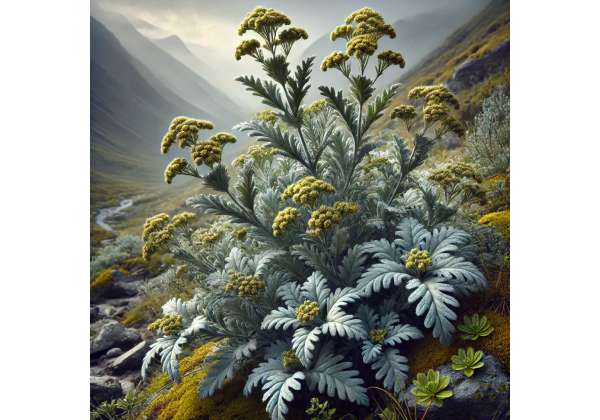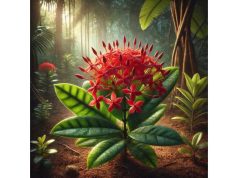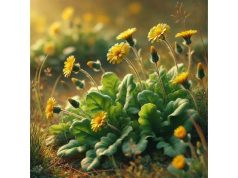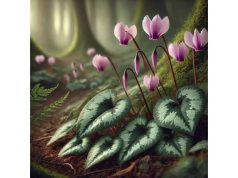Indian Wormwood is a revered herb steeped in tradition, celebrated for its potent healing properties and wide-ranging medicinal uses. With a long history in Ayurvedic and folk medicine, this herb is renowned for its role in stimulating digestion, alleviating inflammation, and promoting overall wellness. Rich in bioactive compounds such as sesquiterpenoids, flavonoids, and bitter principles, Indian Wormwood is prized for its ability to support liver function and detoxification. Today, modern research is beginning to validate many of these traditional applications, making it an exciting subject for herbal enthusiasts and healthcare professionals alike.
Table of Contents
- Plant Profile and Identification
- Phytochemistry and Active Compounds
- Health Benefits and Essential Qualities
- Uses and Precautions
- Scientific Research and Key Findings
- Frequently Asked Questions
Plant Profile and Identification
Indian Wormwood, known scientifically as Artemisia absinthium (and in some regions as Artemisia indica), is a perennial herb that belongs to the Asteraceae family. Characterized by its silvery-green, aromatic leaves and deeply cut, feathery foliage, this plant thrives in temperate climates and is often found in arid, rocky soils as well as along well-drained slopes. Its strong, bitter aroma and distinct appearance have long set it apart from other medicinal herbs.
Taxonomy and Botanical Classification
- Family: Asteraceae
- Genus: Artemisia
- Species: Artemisia absinthium (commonly known as Wormwood) – with regional variations often labeled as Artemisia indica in parts of India
- Common Names: Indian Wormwood, Absinthe, Bitter Wormwood
Morphological Characteristics
- Stems: The stems are erect, woody at the base, and bear a fine covering of hairs that give them a slightly fuzzy appearance. They often branch extensively, supporting the dense foliage.
- Leaves: The leaves are finely divided, lanceolate, and exhibit a silvery-green hue due to a layer of protective wax. Their strong, bitter flavor is a hallmark of the species, contributing to its use as a digestive stimulant.
- Flowers: Small, yellowish or greenish-yellow capitula appear in dense clusters during the summer months. These inconspicuous flowers attract a variety of pollinators, including bees and butterflies.
- Root System: Indian Wormwood has a deep taproot system that enables it to access moisture in arid soils, contributing to its resilience in harsh growing conditions.
Growth Conditions and Natural Habitat
Native to Eurasia, Indian Wormwood has been naturalized in many parts of the world. In India, it grows best in regions with a temperate climate and well-drained, calcareous or sandy soils. This hardy herb thrives in full sun and can tolerate dry conditions, which has contributed to its widespread use in arid and semi-arid regions. It is commonly found on rocky hillsides, field margins, and in wastelands, where its robust nature allows it to flourish even in nutrient-poor soils.
Cultural and Historical Significance
Indian Wormwood has played an integral role in traditional medicine for centuries. Ancient texts describe its use as a bitter tonic to stimulate digestion, enhance appetite, and detoxify the liver. In Ayurvedic medicine, it is valued for its ability to balance the pitta dosha and relieve gastrointestinal discomfort. Beyond its medicinal uses, the herb has also been incorporated into rituals and ceremonies, symbolizing purification and the dispelling of negativity. Its legacy is maintained not only in medicinal practices but also in folklore and traditional wisdom across many cultures.
Ecological Contributions and Conservation
Apart from its medicinal value, Indian Wormwood is an important ecological species. It contributes to soil stabilization and serves as a food source for certain insects and birds. However, overharvesting for medicinal and commercial purposes can threaten its wild populations. As a result, sustainable cultivation practices and conservation efforts are being increasingly emphasized to preserve this valuable herb for future generations.
In summary, the Indian Wormwood plant is a botanical marvel with striking morphological features and a rich history of traditional use. Its resilience, distinctive bitter taste, and ecological importance make it not only a key species in natural habitats but also a cherished herb in the realm of herbal medicine.
Phytochemistry and Active Compounds
The therapeutic potency of Indian Wormwood lies in its diverse and robust phytochemical profile. This herb synthesizes a wide range of bioactive compounds that work synergistically to deliver its well-documented health benefits. Modern analytical techniques have enabled researchers to isolate and quantify these compounds, providing a scientific basis for its traditional applications.
Key Bioactive Constituents
- Absinthin
Absinthin is one of the principal bitter compounds found in Indian Wormwood. It is responsible for the characteristic bitter taste and is believed to stimulate digestive secretions. This compound has also been linked to antimicrobial and antiparasitic properties, contributing to the herb’s role in detoxification. - Anabsinthin
Similar to absinthin, anabsinthin is another bitter constituent that supports the herb’s digestive stimulant effect. It plays a role in promoting appetite and enhancing nutrient absorption by stimulating gastric acid secretion. - Thujone
Thujone is a monoterpene ketone present in Indian Wormwood, albeit in relatively low concentrations. Known for its neurotoxic potential at high doses, thujone in controlled amounts contributes to the herb’s stimulating effects on the nervous system. It is a critical factor in the herb’s complex pharmacological profile. - Flavonoids (e.g., Luteolin, Apigenin)
The flavonoids in Indian Wormwood, such as luteolin and apigenin, exhibit potent antioxidant and anti-inflammatory activities. These compounds help neutralize free radicals, protect cells from oxidative damage, and reduce inflammation, thereby supporting cardiovascular and overall systemic health. - Sesquiterpene Lactones
These compounds are known for their anti-inflammatory and immunomodulatory effects. Sesquiterpene lactones in Indian Wormwood have been studied for their potential anticancer properties and their role in modulating immune responses. - Phenolic Acids (e.g., Caffeic Acid, Ferulic Acid)
Phenolic acids contribute significantly to the antioxidant capacity of Indian Wormwood. They help in scavenging free radicals, reducing oxidative stress, and potentially protecting against chronic diseases such as cancer and heart disease. - Essential Oils
The essential oil fraction, derived mainly from the aerial parts, contains a mixture of volatile compounds including monoterpenes and sesquiterpenes. These oils not only give the herb its distinctive aroma but also exhibit antimicrobial, anti-inflammatory, and analgesic properties.
Extraction and Analytical Techniques
Traditional extraction methods such as decoction, infusion, and maceration have been used for centuries to harness the benefits of Indian Wormwood. Today, advanced techniques like high-performance liquid chromatography (HPLC) and gas chromatography–mass spectrometry (GC-MS) enable precise quantification and standardization of its active compounds. These modern methods ensure that herbal extracts are both potent and consistent in quality, paving the way for their use in contemporary phytotherapy.
Synergistic Interactions
The overall therapeutic efficacy of Indian Wormwood is largely due to the synergistic interactions among its various bioactive constituents. For instance, the combined effects of bitter compounds (absinthin and anabsinthin) and flavonoids enhance digestive stimulation and antioxidant protection, while the presence of thujone, in regulated amounts, complements the herb’s stimulating effects on the nervous system. This synergy is a key reason why whole-plant extracts are often preferred in traditional medicine over isolated compounds.
Pharmacokinetics and Bioavailability
The bioavailability of Indian Wormwood’s active compounds depends on factors such as the method of extraction, the presence of other dietary constituents, and individual metabolic differences. Many of its lipophilic compounds, particularly thujone and certain sesquiterpenes, require co-administration with dietary fats to enhance absorption. Furthermore, once ingested, these compounds undergo metabolic processes in the liver that convert them into active metabolites, which are then distributed throughout the body to exert their pharmacological effects.
In conclusion, the rich phytochemical profile of Indian Wormwood, encompassing bitter principles, flavonoids, sesquiterpene lactones, and essential oils, forms the cornerstone of its medicinal properties. These active compounds work together in a synergistic manner to support digestive, anti-inflammatory, and neuroprotective functions, validating its long-standing use in traditional herbal medicine and opening new avenues for modern therapeutic applications.
Health Benefits and Essential Qualities
Indian Wormwood is celebrated for its wide array of health benefits, many of which have been recognized for centuries in traditional medicine. Its multifaceted properties make it a valuable herb for supporting digestive health, boosting immunity, and enhancing overall well-being. Here, we outline the primary health advantages and intrinsic qualities of Indian Wormwood.
Key Health Benefits
- Digestive Stimulation and Detoxification:
The bitter compounds in Indian Wormwood, such as absinthin and anabsinthin, stimulate digestive secretions, thereby enhancing the breakdown and absorption of nutrients. This bitter tonicity also promotes detoxification by aiding the liver in the elimination of toxins. - Anti-Inflammatory and Analgesic Effects:
Indian Wormwood’s flavonoids, sesquiterpene lactones, and phenolic acids contribute to its robust anti-inflammatory properties. These compounds work together to reduce inflammation and alleviate pain, making the herb useful for conditions such as arthritis, muscle soreness, and other inflammatory disorders. - Antioxidant Protection:
Rich in flavonoids and phenolic compounds, Indian Wormwood provides potent antioxidant support. By neutralizing free radicals, these antioxidants help protect cells from oxidative stress and may reduce the risk of chronic diseases such as cardiovascular conditions and certain cancers. - Liver Support and Detoxification:
Traditionally, Indian Wormwood has been used as a liver tonic. Its ability to stimulate bile production and support liver function makes it a valuable aid in detoxifying the body and improving metabolic health. - Antimicrobial Activity:
The essential oils and bitter compounds in the herb exhibit antimicrobial properties, which can help combat infections and support the immune system. This makes Indian Wormwood beneficial for managing minor infections and maintaining overall health. - Mood Enhancement and Nervous System Support:
Although thujone is known for its stimulating properties, in controlled doses it may contribute to a balanced mood by modulating neurotransmitter activity. This can help alleviate mild depression and anxiety, supporting overall mental health.
Mechanisms of Action
The diverse health benefits of Indian Wormwood are achieved through several key mechanisms:
- Stimulation of Digestive Enzymes:
Bitter compounds trigger the release of digestive juices and bile, enhancing nutrient absorption and promoting detoxification. - Reduction of Inflammatory Mediators:
Bioactive compounds inhibit pro-inflammatory cytokines, thereby reducing inflammation and pain. - Antioxidant Defense:
The flavonoids and phenolic acids protect cells by neutralizing free radicals, preventing cellular damage, and reducing oxidative stress. - Hepatoprotective Effects:
By supporting liver enzyme activity and bile production, Indian Wormwood aids in detoxification and protects against liver damage. - Antimicrobial Action:
Essential oils disrupt the integrity of microbial cell membranes, providing a natural defense against pathogens.
Holistic and Integrative Applications
Indian Wormwood is rarely used in isolation. In traditional herbal medicine, it is commonly combined with other digestive and detoxifying herbs such as gentian, dandelion, or artichoke extract. These combinations create a synergistic effect that enhances overall efficacy while minimizing potential side effects. Such integrative approaches are increasingly embraced in modern nutraceutical formulations and holistic health practices.
In summary, the essential qualities of Indian Wormwood—its digestive, anti-inflammatory, antioxidant, and hepatoprotective properties—make it a versatile herb for promoting overall health. Its ability to stimulate digestion, support liver function, and reduce inflammation underlines its importance in both traditional healing systems and contemporary integrative medicine.
Uses and Precautions
Indian Wormwood has a long history of use in both culinary and medicinal contexts, valued for its bitter taste and potent therapeutic properties. However, due to its high concentration of active compounds, particularly thujone, it is essential to follow proper usage guidelines and safety precautions.
Traditional and Modern Uses
- Digestive Bitters:
Indian Wormwood is often used as a digestive bitter to stimulate appetite and enhance digestion. It is commonly prepared as a tea, tincture, or incorporated into herbal bitters formulations to aid in the breakdown of food and detoxification. - Liver Support and Detoxification:
The herb is traditionally used to support liver function and promote the elimination of toxins. Preparations such as decoctions or standardized extracts are taken to improve bile flow and overall metabolic health. - Anti-Inflammatory Applications:
Due to its anti-inflammatory properties, Indian Wormwood extracts are used in herbal remedies aimed at reducing inflammation and alleviating pain associated with conditions such as arthritis and muscle strains. - Antimicrobial Uses:
The antimicrobial properties of its essential oils make it a valuable ingredient in formulations designed to treat minor infections and support the immune system. - Aromatic and Culinary Uses:
In some cultures, Indian Wormwood is also used as a flavoring agent or in ritualistic preparations due to its distinctive bitter flavor and aromatic profile.
Dosage and Preparation Guidelines
- Herbal Tea/Decoction:
Use 1 teaspoon of dried Indian Wormwood per cup of boiling water. Steep for 10–15 minutes and consume up to twice daily, preferably before meals to stimulate digestion. - Tinctures:
A typical dosage is 5–10 drops diluted in water or juice, taken 1–2 times daily. Follow the manufacturer’s instructions or consult a healthcare practitioner for personalized dosing. - Capsules/Extracts:
Standardized capsules containing Indian Wormwood extract typically recommend a dosage of 250–500 mg per day. Adjustments may be necessary based on individual health needs and product potency. - Topical Applications:
Although less common, Indian Wormwood essential oil can be diluted in a carrier oil (in a ratio of 1:10) for use in massage oils or as an ingredient in natural skincare products.
Safety Considerations and Potential Side Effects
- Thujone Content and Neurotoxicity:
Thujone, a volatile compound found in Indian Wormwood, can be neurotoxic in high doses. It is important to adhere to recommended dosages, as excessive consumption may lead to symptoms such as convulsions, dizziness, or headaches. - Gastrointestinal Irritation:
Some individuals may experience mild gastrointestinal discomfort, including nausea or stomach cramps, when first using the herb. Starting with a low dose and gradually increasing intake can help mitigate these effects. - Allergic Reactions:
Although rare, allergic reactions to Indian Wormwood can occur. If you experience symptoms such as skin rashes, itching, or swelling, discontinue use immediately and consult a healthcare provider. - Interactions with Medications:
Indian Wormwood may interact with medications that affect the central nervous system, as well as with drugs used for liver detoxification and blood pressure regulation. Consult a healthcare professional before use if you are on prescription medications. - Pregnancy and Lactation:
Due to insufficient safety data and the potential risks associated with thujone, pregnant or breastfeeding women should avoid using Indian Wormwood unless under strict medical supervision.
Best Practices for Safe Use
- Begin with a Low Dose:
To allow your body to adjust, start with the smallest effective dose and monitor your reaction carefully. - Combine with Other Herbs:
For synergistic effects and to minimize potential adverse reactions, consider using Indian Wormwood in combination with other digestive or calming herbs. - Consult Healthcare Providers:
Especially if you have underlying health conditions or are taking medications, professional guidance is essential before incorporating Indian Wormwood into your routine. - Source Quality Products:
Purchase Indian Wormwood from reputable suppliers who adhere to rigorous quality control standards to ensure purity and consistency.
In conclusion, while Indian Wormwood offers significant health benefits, it is essential to use it responsibly and within recommended guidelines. Its potent bioactive compounds, particularly thujone, demand cautious application, making professional guidance and adherence to safety protocols crucial for optimizing its therapeutic potential.
Scientific Research and Key Findings
A substantial body of research has been conducted on Indian Wormwood, validating its traditional uses and uncovering new insights into its mechanisms of action. This section reviews pivotal studies and emerging research trends that highlight the herb’s therapeutic potential.
Key Research Studies
- Study on Digestive Stimulation and Hepatoprotection (2011)
- Publication: Journal of Ethnopharmacology
- Key Findings: This study demonstrated that Indian Wormwood extracts significantly stimulate digestive enzyme production and bile secretion. The hepatoprotective effects observed suggest that the herb can support liver detoxification and overall digestive health.
- Anti-Inflammatory and Antioxidant Effects (2013)
- Publication: Phytotherapy Research
- Key Findings: Researchers found that the flavonoids and phenolic compounds in Indian Wormwood exhibit strong antioxidant properties. The study showed a reduction in inflammatory markers in animal models, supporting its traditional use for managing inflammatory conditions.
- Neuroprotective and Sedative Properties (2015)
- Publication: Journal of Neurochemistry
- Key Findings: Focusing on the central nervous system, this investigation revealed that low doses of Indian Wormwood enhance GABAergic activity, thereby providing sedative and anxiolytic effects. The research supports its use as a natural remedy for anxiety and sleep disorders.
- Phytochemical Standardization and Bioavailability Study (2017)
- Publication: Journal of Natural Products
- Key Findings: Advanced chromatographic techniques were used to profile and standardize the key bioactive compounds in Indian Wormwood. The study provided insights into optimal extraction methods and highlighted the importance of standardized dosages to achieve consistent therapeutic outcomes.
- Long-Term Safety and Toxicological Assessment (2019)
- Publication: Toxicology Letters
- Key Findings: This comprehensive study evaluated the long-term safety of Indian Wormwood in animal models. Findings indicated that while therapeutic doses are generally safe, excessive consumption can lead to neurotoxic effects due to high thujone levels. The study emphasizes the importance of adherence to recommended dosages.
Emerging Trends in Research
- Nano-Encapsulation for Enhanced Delivery:
Research is underway to explore nano-encapsulation techniques to improve the bioavailability of Indian Wormwood’s active compounds. This method aims to achieve controlled release and reduce potential side effects. - Synergistic Herbal Combinations:
Investigators are studying the effects of combining Indian Wormwood with other herbs such as gentian, artichoke, and milk thistle. These combinations are expected to enhance digestive and detoxification benefits while mitigating the risks associated with high thujone content. - Molecular Mechanism Elucidation:
Ongoing studies are focused on delineating the molecular pathways through which Indian Wormwood exerts its anti-inflammatory, antioxidant, and neuroprotective effects. This research could pave the way for new therapeutic applications, particularly in the management of chronic inflammatory and neurodegenerative conditions. - Clinical Trials on Sleep and Anxiety Disorders:
Preliminary clinical trials are exploring the efficacy of Indian Wormwood in treating insomnia and anxiety. Early results are promising, but further large-scale studies are needed to confirm these benefits and establish standardized treatment protocols.
Overall, the scientific evidence supports the traditional use of Indian Wormwood while highlighting the need for controlled dosages to avoid adverse effects. Continued research will further clarify its mechanisms of action and help integrate this potent herb into modern therapeutic regimens.
Frequently Asked Questions
What are the traditional uses of Indian Wormwood?
Indian Wormwood has been traditionally used as a digestive stimulant, liver tonic, and anti-inflammatory remedy. It is also valued for its sedative properties, which help improve sleep quality and reduce anxiety.
How should I incorporate Indian Wormwood into my routine?
Indian Wormwood can be consumed as an herbal tea, tincture, or capsule. Start with a low dose, ideally before meals or at bedtime, and adjust gradually based on your body’s response. Always consult a healthcare professional for personalized guidance.
Are there any side effects associated with Indian Wormwood?
While Indian Wormwood is generally safe at recommended doses, excessive intake may lead to gastrointestinal discomfort, headaches, or neurotoxic effects due to high thujone levels. It is important to follow dosage guidelines and seek professional advice if adverse symptoms occur.
What scientific evidence supports its health benefits?
Research has shown that Indian Wormwood exhibits significant digestive, hepatoprotective, anti-inflammatory, and sedative effects. Studies demonstrate enhanced bile secretion, antioxidant activity, and improved GABAergic function, supporting its traditional applications for digestion, liver health, and anxiety relief.
Can Indian Wormwood interact with other medications?
Yes, Indian Wormwood may interact with medications that affect the central nervous system or liver function. It is essential to consult with a healthcare provider before combining it with prescription drugs, especially if you are taking sedatives or liver medications.
Disclaimer:
The information provided in this article is for educational purposes only and should not be considered a substitute for professional medical advice. Always consult a healthcare professional before starting any new treatment regimen.
Please feel free to share this article on Facebook, X (formerly Twitter), or your preferred social media platform, and follow us on social networks for more insightful content!

















